Bosch NBC-255-P User Manual
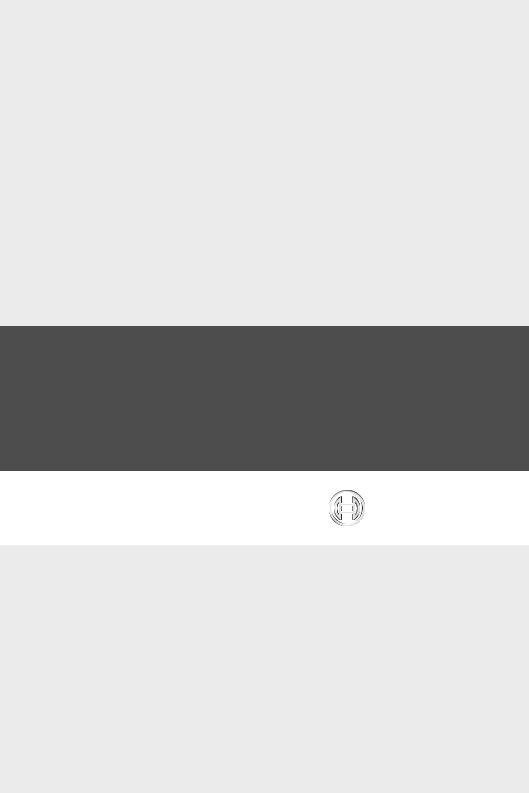
IP Camera 200 Series
NBC-255-P
en Installation and Operation Manual

IP Camera 200 Series |
Table of Contents | en 3 |
|
|
|
|
Table of Contents |
|
|
|
|
|
1 |
Safety |
7 |
1.1 |
Safety precautions |
7 |
1.2 |
Important safety instructions |
8 |
1.3 |
FCC & ICES compliance |
9 |
1.4 |
UL certification |
11 |
1.5 |
Bosch notices |
11 |
1.6 |
Copyrights |
12 |
|
|
|
2 |
Introduction |
13 |
2.1 |
Features |
13 |
2.2 |
Unpacking |
14 |
|
|
|
3 |
Installation |
15 |
3.1 |
Power connection |
15 |
3.1.1 |
DC power connection |
15 |
3.2 |
Network (and power) connector |
16 |
3.3 |
I/O connector |
17 |
3.4 |
Audio connectors |
18 |
3.5 |
Resetting the camera |
18 |
3.6 |
SD card |
19 |
3.7 |
Mounting the camera |
19 |
|
|
|
4 |
Browser connection |
21 |
4.1 |
System requirements |
21 |
4.2 |
Establishing the connection |
21 |
4.2.1 |
Password protection in camera |
22 |
4.3 |
Protected network |
22 |
4.4 |
Connection established |
23 |
4.4.1 |
LIVEPAGE |
23 |
4.4.2 |
RECORDINGS |
23 |
4.4.3 |
SETTINGS |
23 |
Bosch Security Systems |
Installation and Operation Manual |
AR18-09-B003 | v1.1 | 2010.05 |

4 en | Table of Contents |
IP Camera 200 Series |
|
|
|
|
|
|
|
5 |
Basic Mode |
25 |
5.1 |
Basic Mode menu tree |
25 |
5.2 |
Device Access |
26 |
5.2.1 |
Camera name |
26 |
5.2.2 |
Password |
26 |
5.3 |
Date/Time |
27 |
5.4 |
Network |
28 |
5.5 |
Encoder Profile |
29 |
5.6 |
Audio |
29 |
5.7 |
Recording |
29 |
5.7.1 |
Storage medium |
29 |
5.8 |
System Overview |
29 |
|
|
|
6 |
Advanced Mode |
30 |
6.1 |
Advanced Mode menu tree |
30 |
6.2 |
General |
31 |
6.2.1 |
Identification |
31 |
6.2.2 |
Password |
31 |
6.2.3 |
Date/Time |
32 |
6.2.4 |
Display Stamping |
34 |
6.3 |
Web Interface |
36 |
6.3.1 |
Appearance |
36 |
6.3.2 |
LIVEPAGE Functions |
37 |
6.3.3 |
Logging |
38 |
6.4 |
Camera |
39 |
6.4.1 |
Encoder Profile |
39 |
6.4.2 |
Encoder Streams |
42 |
6.4.3 |
Video |
43 |
6.4.4 |
Audio |
44 |
6.4.5 |
Installer Options |
44 |
6.5 |
Recording |
45 |
6.5.1 |
Storage Management |
46 |
6.5.2 |
Recording Profiles |
49 |
6.5.3 |
Retention Time |
50 |
6.5.4 |
Recording Scheduler |
51 |
6.5.5 |
Recording Status |
52 |
AR18-09-B003 | v1.1 | 2010.05 |
Installation and Operation Manual |
Bosch Security Systems |

IP Camera 200 Series |
Table of Contents | en 5 |
|
|
|
|
6.6 |
Alarm |
53 |
6.6.1 |
Alarm Connections |
53 |
6.6.2 |
Video Content Analyses (VCA) |
56 |
6.6.3 |
VCA configurationProfiles |
57 |
6.6.4 |
VCA configuration - Scheduled |
63 |
6.6.5 |
VCA configuration - Event triggered |
65 |
6.6.6 |
Audio Alarm |
66 |
6.6.7 |
Alarm E-Mail |
67 |
6.7 |
Interfaces |
69 |
6.7.1 |
Alarm input |
69 |
6.7.2 |
Relay |
69 |
6.8 |
Network |
71 |
6.8.1 |
Network |
71 |
6.8.2 |
Advanced |
75 |
6.8.3 |
Multicasting |
76 |
6.8.4 |
JPEG Posting |
77 |
6.9 |
Service |
79 |
6.9.1 |
Maintenance |
79 |
6.9.2 |
System Overview |
81 |
|
|
|
7 |
Operation via the browser |
82 |
7.1 |
Livepage |
82 |
7.1.1 |
Processor load |
82 |
7.1.2 |
Image selection |
83 |
7.1.3 |
Digital I/O |
83 |
7.1.4 |
System Log / Event Log |
83 |
7.1.5 |
Saving snapshots |
83 |
7.1.6 |
Recording video sequences |
83 |
7.1.7 |
Running recording program |
84 |
7.1.8 |
Audio communication |
84 |
7.2 |
Recordings page |
85 |
7.2.1 |
Controlling playback |
86 |
|
|
|
8 |
Troubleshooting |
88 |
8.1 |
Resolving problems |
88 |
8.2 |
Customer service |
88 |
Bosch Security Systems |
Installation and Operation Manual |
AR18-09-B003 | v1.1 | 2010.05 |

6 en | Table of Contents |
IP Camera 200 Series |
|
|
|
|
|
|
|
9 |
Maintenance |
89 |
9.1 |
Repairs |
89 |
9.1.1 |
Transfer and disposal |
89 |
|
|
|
10 |
Technical Data |
90 |
10.1 |
Specifications |
90 |
10.1.1 |
Dimensions |
92 |
10.1.2 |
Accessories |
92 |
AR18-09-B003 | v1.1 | 2010.05 |
Installation and Operation Manual |
Bosch Security Systems |
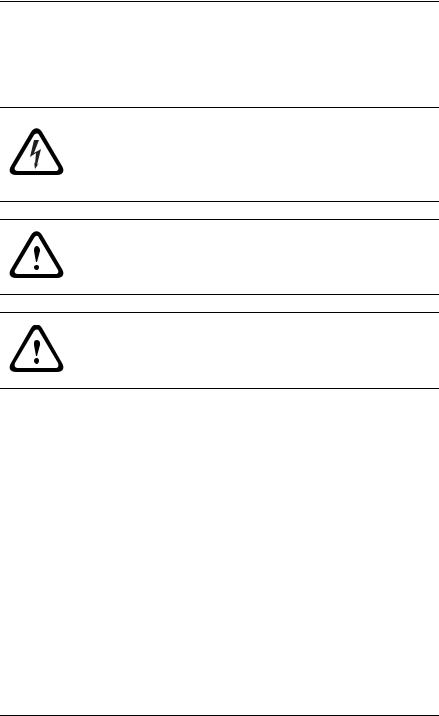
IP Camera 200 Series |
Safety | en |
7 |
|
|
|
1Safety
1.1Safety precautions
DANGER!
High risk: This symbol indicates an imminently hazardous situation such as "Dangerous Voltage" inside the product. If not avoided, this will result in an electrical shock, serious bodily injury, or death.
WARNING!
Medium risk: Indicates a potentially hazardous situation.
If not avoided, this could result in minor or moderate bodily injury.
CAUTION!
Low risk: Indicates a potentially hazardous situation.
If not avoided, this could result in property damage or risk of damage to the device.
Bosch Security Systems |
Installation and Operation Manual |
AR18-09-B003 | v1.1 | 2010.05 |

8 en | Safety |
IP Camera 200 Series |
|
|
1.2Important safety instructions
Read, follow, and retain for future reference all of the following safety instructions. Heed all warnings on the unit and in the operating instructions before operating the unit.
1.Cleaning - Generally, using a dry cloth for cleaning is sufficient but a moist, fluff-free cloth or leather shammy may also be used. Do not use liquid cleaners or aerosol cleaners.
2.Heat Sources - Do not install the unit near any heat sources such as radiators, heaters, stoves, or other equipment (including amplifiers) that produce heat.
3.Water - Never spill liquid of any kind on the unit.
4.Lightning - Take precautions to protect the unit from power and lightning surges.
5.Controls adjustment - Adjust only those controls specified in the operating instructions. Improper adjustment of other controls may cause damage to the unit.
6.Power sources - Operate the unit only from the type of power source indicated on the label.
7.Servicing - Unless qualified, do not attempt to service this unit yourself. Refer all servicing to qualified service personnel.
8.Replacement parts - Use only replacement parts specified by the manufacturer.
9.Installation - Install in accordance with the manufacturer's instructions and in accordance with applicable local codes.
10.Attachments, changes or modifications - Only use attachments/accessories specified by the manufacturer. Any change or modification of the equipment, not expressly approved by Bosch, could void the warranty or, in the case of an authorization agreement, authority to operate the equipment.
AR18-09-B003 | v1.1 | 2010.05 |
Installation and Operation Manual |
Bosch Security Systems |

IP Camera 200 Series |
Safety | en |
9 |
|
|
|
1.3FCC & ICES compliance
FCC & ICES Information
(U.S.A. and Canadian Models Only)
This equipment has been tested and found to comply with the limits for a Class B digital device, pursuant to part 15 of the FCC Rules. These limits are designed to provide reasonable protection against harmful interference in a residential installation. This equipment generates, uses, and can radiate radio frequency energy and, if not installed and used in accordance with the instructions, may cause harmful interference to radio communications. However, there is no guarantee that interference will not occur in a particular installation. If this equipment does cause harmful interference to radio or television reception, which can be determined by turning the equipment off and on, the user is encouraged to try to correct the interference by one or more of the following measures:
–reorient or relocate the receiving antenna;
–increase the separation between the equipment and receiver;
–connect the equipment into an outlet on a circuit different from that to which the receiver is connected;
–consult the dealer or an experienced radio/TV technician
for help.
Intentional or unintentional modifications, not expressly approved by the party responsible for compliance, shall not be made. Any such modifications could void the user's authority to operate the equipment. If necessary, the user should consult the dealer or an experienced radio/television technician for corrective action.
The user may find the following booklet, prepared by the Federal Communications Commission, helpful: How to Identify and Resolve Radio-TV Interference Problems. This booklet is available from the U.S. Government Printing Office, Washington, DC 20402, Stock No. 004-000-00345-4.
Bosch Security Systems |
Installation and Operation Manual |
AR18-09-B003 | v1.1 | 2010.05 |

10 en | Safety |
IP Camera 200 Series |
|
|
Informations FCC et ICES
(modèles utilisés aux États-Unis et au Canada uniquement)
Suite à différents tests, cet appareil s'est révélé conforme aux exigences imposées aux appareils numériques de classe B, en vertu de la section 15 du règlement de la Commission fédérale des communications des États-Unis (FCC), et en vertu de la norme ICES-003 d'Industrie Canada. Ces exigences visent à fournir une protection raisonnable contre les interférences nuisibles lorsque l'appareil est utilisé dans le cadre d'une installation résidentielle. Cet appareil génère, utilise et émet de l'énergie de radiofréquences et peut, en cas d'installation ou d'utilisation non conforme aux instructions, engendrer des interférences nuisibles au niveau des radiocommunications. Toutefois, rien ne garantit l'absence d'interférences dans une installation particulière. Il est possible de déterminer la production d'interférences en mettant l'appareil successivement hors et sous tension, tout en contrôlant la réception radio ou télévision. L'utilisateur peut parvenir à éliminer les interférences éventuelles en prenant une ou plusieurs des mesures suivantes:
–Modifier l'orientation ou l'emplacement de l'antenne réceptrice;
–Éloigner l'appareil du récepteur;
–Brancher l'appareil sur une prise située sur un circuit différent de celui du récepteur;
–Consulter le revendeur ou un technicien qualifié en radio/ télévision pour obtenir de l'aide.
Toute modification apportée au produit, non expressément approuvée par la partie responsable de l'appareil, est strictement interdite. Une telle modification est susceptible d'entraîner la révocation du droit d'utilisation de l'appareil. La brochure suivante, publiée par la Commission fédérale des
communications (FCC), peut s'avérer utile : How to Identify and Resolve Radio-TV Interference Problems. Cette brochure est disponible auprès du U.S. Government Printing Office, Washington, DC 20402, États-Unis, sous la référence n° 004- 000-00345-4.
AR18-09-B003 | v1.1 | 2010.05 |
Installation and Operation Manual |
Bosch Security Systems |
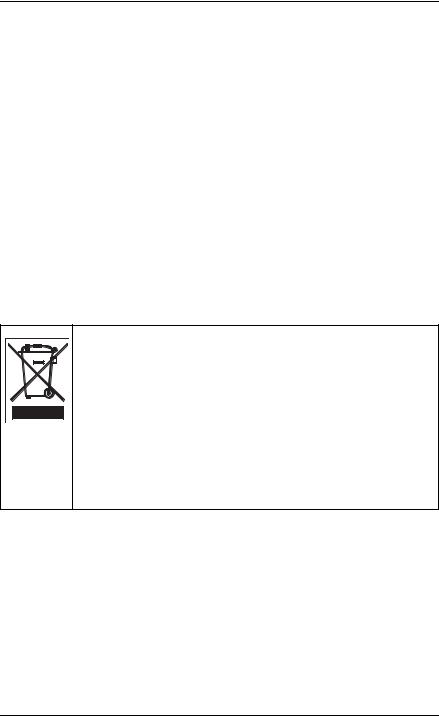
IP Camera 200 Series |
Safety | en 11 |
|
|
1.4UL certification
Disclaimer
Underwriter Laboratories Inc. ("UL") has not tested the performance or reliability of the security or signaling aspects of this product. UL has only tested fire, shock and/or casualty hazards as outlined in UL's Standard(s) for Safety for Closed Circuit Television Equipment, UL 2044. UL Certification does not cover the performance or reliability of the security or signaling aspects of this product.
UL MAKES NO REPRESENTATIONS, WARRANTIES, OR CERTIFICATIONS WHATSOEVER REGARDING THE PERFORMANCE OR RELIABILITY OF ANY SECURITY OR SIGNALING RELATED FUNCTIONS OF THIS PRODUCT.
1.5Bosch notices
Disposal - Your Bosch product was developed and manufactured with high-quality material and components that can be recycled and reused. This symbol means that electronic and electrical appliances, which have reached the end of their working life, must be collected and disposed of separately from household waste material. Separate collecting systems are usually in place for disused electronic and electrical products. Please dispose of these devices at an environmentally compatible recycling facility, per European Directive 2002/96/EC
More information
For more information please contact the nearest Bosch Security Systems location or visit www.boschsecurity.com
Bosch Security Systems |
Installation and Operation Manual |
AR18-09-B003 | v1.1 | 2010.05 |

12 en | Safety |
IP Camera 200 Series |
|
|
1.6Copyrights
The firmware 4.1 uses the fonts "Adobe-Helvetica-Bold-R- Normal--24-240-75-75-P-138-ISO10646-1" and "Adobe- Helvetica-Bold-R-Normal--12-120-75-75-P-70-ISO10646-1" under the following copyright:
Copyright 1984-1989, 1994 Adobe Systems Incorporated. Copyright 1988, 1994 Digital Equipment Corporation. Permission to use, copy, modify, distribute and sell this software and its documentation for any purpose and without fee is hereby granted, provided that the above copyright notices appear in all copies and that both those copyright notices and this permission notice appear in supporting documentation, and that the names of Adobe Systems and Digital Equipment Corporation not be used in advertising or publicity pertaining to distribution of the software without specific, written prior permission.
This software is based in part on the work of the Independent JPEG Group.
AR18-09-B003 | v1.1 | 2010.05 |
Installation and Operation Manual |
Bosch Security Systems |

IP Camera 200 Series |
Introduction | en 13 |
|
|
2Introduction
2.1Features
This IP camera is a ready-to-use, complete network video surveillance system inside a compact camera. The camera offers a cost-effective solution for a broad range of applications. It uses H.264 compression technology to give clear images reducing bandwidth and storage.The camera can be used as a stand-alone video surveillance system with no additional equipment or it can easily integrate with the Bosch Divar 700 Series recorders.
Features include:
–SD/SDHC card slot supports edge recording up to 32 GB
–Tri-streaming: Two H.264 streams and one M-JPEG stream
–Progressive scan for sharp images of moving objects
–Two-way audio and audio alarm
–Power over Ethernet (IEEE 802.3af compliant)
–Tamper and motion detection
–Complies with the ONVIF standard for wide compatibility
Bosch Security Systems |
Installation and Operation Manual |
AR18-09-B003 | v1.1 | 2010.05 |
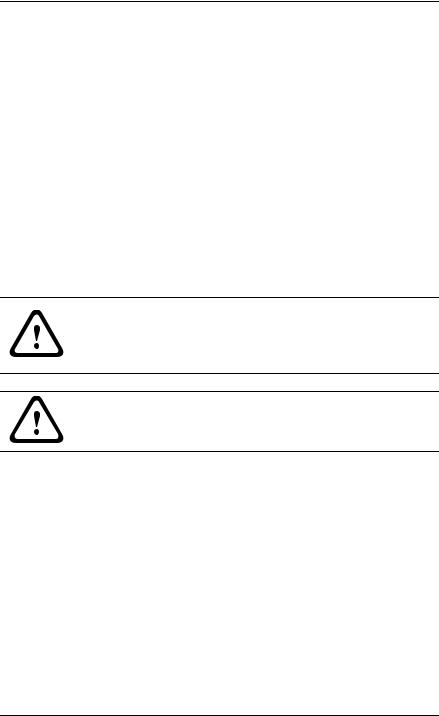
14 en | Introduction |
IP Camera 200 Series |
|
|
2.2Unpacking
Unpack carefully and handle the equipment with care.
The packaging contains:
–IP camera with lens
–Universal power supply with US, EU and UK plug
–Camera mount kit
–Quick installation guide
–CD ROM
–BVIP Lite Suite
–Documentation
–Tools
If equipment has been damaged during shipment, repack it in the original packaging and notify the shipping agent or supplier.
WARNING!
Installation should only be performed by qualified service personnel in accordance with the National Electrical Code or applicable local codes.
CAUTION!
The camera module is a sensitive device and must be handled carefully.
AR18-09-B003 | v1.1 | 2010.05 |
Installation and Operation Manual |
Bosch Security Systems |

IP Camera 200 Series |
Installation | en 15 |
|
|
3Installation
3.1Power connection
3.1.1DC power connection
1 |
|
|
|
|
2 |
|
|
|
|
|
3 |
|
|
|
|
|
4 |
|
|
I/O |
|
|
|
|
Line- |
DC12V |
Ethe |
||
|
|
out |
|
|
|
|
|
Reset |
rnet |
|
|
|
|
|
|
|
|
|
Line- |
|
|
|
|
in |
Figure 3.1 DC power connection
1.Slide the plug adapter that matches your outlet socket onto the supplied power supply.
2.Insert the power connector jack from the power supply into the DC12V socket of the camera.
3.Connect the power supply to either a 230 VAC or a 120 VAC power supply outlet.
When power is supplied to the camera the LED on the bottomfront of the camera lights. (This LED can be disabled in the Installer Options menu.)
Note:
The date/time must be synchronized each time after power on. It is important to ensure that the date/time is correct for recording. An incorrect date/time setting could prevent correct recording.
Bosch Security Systems |
Installation and Operation Manual |
AR18-09-B003 | v1.1 | 2010.05 |
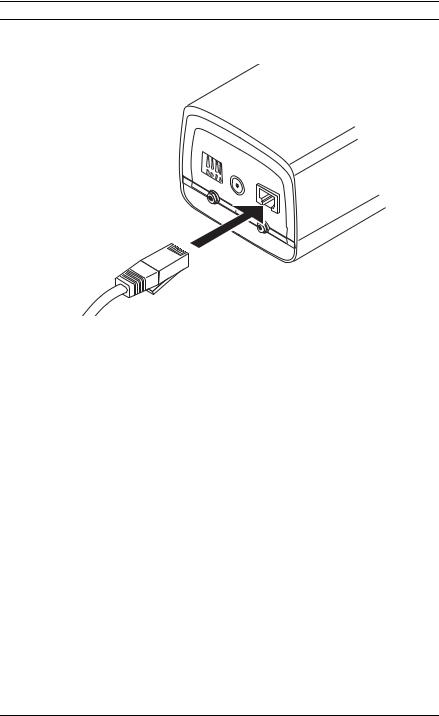
16 en | Installation |
IP Camera 200 Series |
3.2Network (and power) connector
1 |
|
|
2 |
|
|
|
3 |
|
|
|
4 |
I/O |
|
|
DC12V
Figure 3.2 Network connection
–Connect the camera to a 10/100 Base-T network.
–Use a shielded UTP Category 5e cable with RJ45 connectors.
–Power can be supplied to the camera via the Ethernet cable compliant with the Power-over-Ethernet
(IEEE 802.3af) standard.
Note:
The camera can accept power from both the DC12V power input and the Ethernet input at the same time. The primary source is the DC12V input. If both are connected and DC power removed, the camera will reboot and will then be powered by PoE. If both are connected and the PoE removed, the camera will continue working.
AR18-09-B003 | v1.1 | 2010.05 |
Installation and Operation Manual |
Bosch Security Systems |
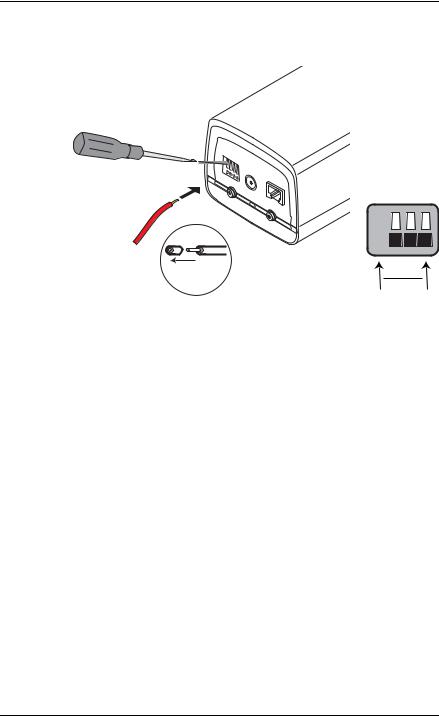
IP Camera 200 Series |
Installation | en 17 |
|
|
3.3I/O connector
1 |
|
|
|
|
|
2 |
|
|
|
|
|
|
3 |
|
|
|
|
|
|
4 |
|
|
|
I/O |
|
|
|
|
|
Line- |
DC12V |
|
erne |
||
|
|
||||
|
|
out |
Reset |
Eth |
|
|
|
t |
|||
|
|
|
|
||
|
|
|
|
Line- |
|
|
|
|
|
|
in |
5 mm
(0.2 in)
Figure 3.3 I/O connector pins
I/O
|
|
|
|
|
|
|
|
|
|
Pin 1 |
Pin 4 |
|||
Function |
Pin |
I/O socket |
|
|
|
Relay |
1 |
Relay out contact 1 |
|
|
|
|
2 |
Relay out contact 2 |
|
|
|
Alarm input |
3 |
Trigger in Positive |
|
|
|
|
4 |
Trigger in Negative |
|
|
|
–Max. wire diameter AWG 22-28 for both stranded and solid; cut back 5 mm (0.2 in) of insulation.
–Relay output switching capability: Max. voltage 24 VAC or 24 VDC. Max. 1 A continuous, 12 VA.
–Trigger in: +9 VDC minimum; +30 VDC maximum. Reverse polarity connection will be inactive.
–Alarm input configurable as active low or active high.
Bosch Security Systems |
Installation and Operation Manual |
AR18-09-B003 | v1.1 | 2010.05 |
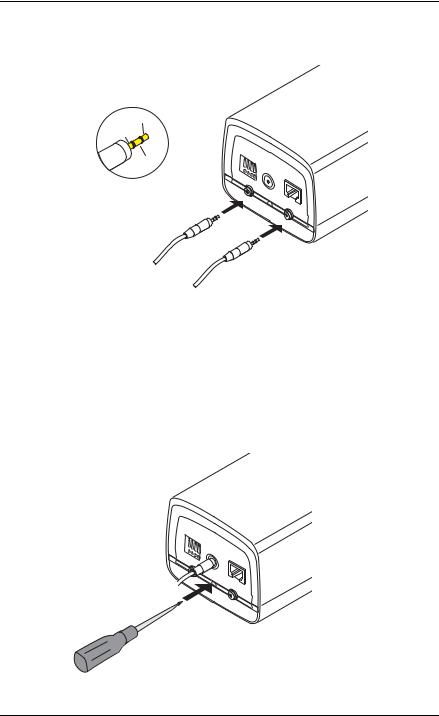
18 en | Installation |
IP Camera 200 Series |
|
|
3.4Audio connectors
Line in: 9 kOhm typ., 200 mVrms Line out: 16 Ohm min. 200 mVrms
Line - L
GND
Line - R
1 |
|
|
|
|
2 |
|
|
|
|
|
3 |
|
|
|
|
|
4 |
|
|
I/O |
|
|
|
|
Line- |
DC12V |
|
||
|
|
out |
Reset |
Ethernet |
|
|
|
||
|
|
|
Line- |
|
|
|
|
|
|
|
|
|
|
in |
Figure 3.4 Audio connectors
Connect audio devices to the Line In and Line Out connectors.
3.5Resetting the camera
If the camera cannot be connected because the IP address has changed, press and hold the reset button (7 seconds approximately) until the LED flashes (red) to recall the factory default values. The factory default IP address is 192.168.0.1
1 |
|
|
2 |
|
|
|
3 |
|
|
|
4 |
|
|
out |
Line-in
Figure 3.5 Reset button
AR18-09-B003 | v1.1 | 2010.05 |
Installation and Operation Manual |
Bosch Security Systems |
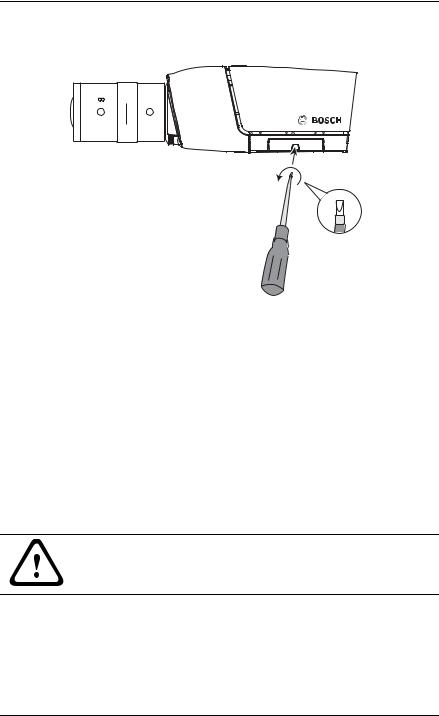
IP Camera 200 Series |
Installation | en 19 |
|
|
3.6SD card
|
C |
|
W |
N |
T |
|
O |
Figure 3.6 SD card
1.Unscrew the cover on the right side of the camera.
2.Slide the SD card into the slot.
3.Close and secure the cover.
The camera supports most SD/SDHC cards.
3.7Mounting the camera
The camera can be mounted either from the top or from the bottom (1/4"-20 UNC thread). The mounting socket is isolated from ground to prevent ground loops.
CAUTION!
Do not point the camera/lens into direct sunlight as this may damage the sensors.
Bosch Security Systems |
Installation and Operation Manual |
AR18-09-B003 | v1.1 | 2010.05 |

20 en | Installation |
IP Camera 200 Series |
|
|
120°
27 mm
120° |
|
3x Ø3.8 mm |
3x Ø6 mm |
D: 26 mm |
D: 26 mm |
Figure 3.7 Mounting a camera
1.Use three screws to secure the base of the mounting unit to a wood (Ø3.8 mm, 26 mm deep) or concrete (Ø6 mm, 26 mm deep) surface.
2.On the mounting unit, loosen the ball-socket adjustment ring (2).
3.Adjust the ball-socket so that camera mount is correcrly aligned for the required angle.
4.Screw camera onto mount and, when in position, tighten the locking ring (1) securely.
5.Tighten the ball-socket adjustment ring (2) securely.
AR18-09-B003 | v1.1 | 2010.05 |
Installation and Operation Manual |
Bosch Security Systems |

IP Camera 200 Series |
Browser connection | en 21 |
|
|
4Browser connection
A computer with Microsoft Internet Explorer can be used to receive live images from the camera, control cameras, and replay stored sequences. The camera is configured over the network using a browser or via the BVIP Lite Suite (supplied with the product).
4.1System requirements
–Microsoft Internet Explorer version 7.0 or higher
–Monitor: resolution at least 1024 × 768 pixels, 16 or 32 bit color depth
–Intranet or Internet network access
The Web browser must be configured to enable Cookies to be set from the IP address of the unit.
In Windows Vista, deactivate protected mode on the Security tab under Internet Options.
To play back live video images, an appropriate ActiveX must be installed on the computer. If necessary, the required software and controls can be installed from the product CD provided.
a.Insert the CD into the CD-ROM drive of the computer. If the CD does not start automatically, open the root directory of the CD in Windows Explorer and double click start.exe
b.Follow the on-screen instructions.
4.2Establishing the connection
The camera must be assigned a valid IP address to operate on your network. The default address pre-set at the factory is
192.168.0.1
1.Start the Web browser.
2.Enter the IP address of the camera as the URL.
Bosch Security Systems |
Installation and Operation Manual |
AR18-09-B003 | v1.1 | 2010.05 |

22 en | Browser connection |
IP Camera 200 Series |
|
|
Note:
If the connection is not established, the maximum number of possible connections may already have been reached. Depending on the device and network configuration, up to 25 web browsers, or 50 VIDOS or Bosch VMS connections are supported.
4.2.1Password protection in camera
A camera offers the option of limiting access across various authorization levels. If the camera is password-protected, a message to enter the password appears.
1.Enter the user name and the associated password in the appropriate fields.
2.Click OK. If the password is correct, the desired page is displayed.
4.3Protected network
If a Radius server is used for network access control (802.1x authentication), the camera must be configured first. To configure the camera for a Radius network, connect it directly to a PC via a crossed network cable and configure the two parameters, Identity and Password. Only after these have been configured can communication with the camera via the network occur.
AR18-09-B003 | v1.1 | 2010.05 |
Installation and Operation Manual |
Bosch Security Systems |
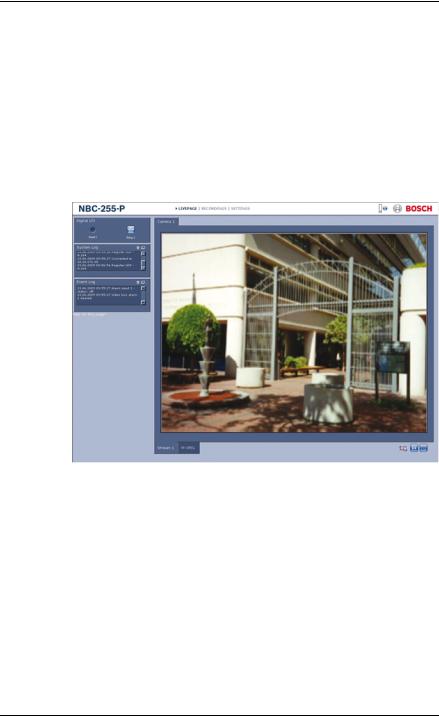
IP Camera 200 Series |
Browser connection | en 23 |
|
|
4.4Connection established
When a connection is established, the LIVEPAGE is initially displayed. The application title bar displays the type number of the connected camera and three items: LIVEPAGE,
RECORDINGS, SETTINGS.
Note:
The RECORDINGS link is only visible if a storage medium is available.
Figure 4.1 Livepage
4.4.1LIVEPAGE
The LIVEPAGE is used to display and control the video stream. Refer to Section 7.1 Livepage, page 82 for more information.
4.4.2RECORDINGS
Click RECORDINGS in the application title bar to open the playback page. Refer to Section 7.2 Recordings page, page 85 for more information.
4.4.3SETTINGS
Click SETTINGS in the application title bar to configure the camera and the application interface. A new page containing
Bosch Security Systems |
Installation and Operation Manual |
AR18-09-B003 | v1.1 | 2010.05 |

24 en | Browser connection |
IP Camera 200 Series |
|
|
the configuration menu is opened. All settings (except date/ time) are stored in the camera memory so that they are retained, even if the power is interrupted.
Changes that influence the fundamental functioning of the unit (for example, firmware updates) can only be made using the configuration menu.
The configuration menu tree allows all parameters of the unit to be configured. The configuration menu is divided into Basic Mode and Advanced Mode.
Refer to Section 5 Basic Mode, page 25 for more information on basic settings; refer to Section 6 Advanced Mode, page 30 for more information on advanced settings.
Note:
It is recommended that only expert users or system administrators use the Advanced Mode.
AR18-09-B003 | v1.1 | 2010.05 |
Installation and Operation Manual |
Bosch Security Systems |

IP Camera 200 Series |
Basic Mode | en 25 |
|
|
5Basic Mode
5.1Basic Mode menu tree
The basic mode configuration menu allows a set of basic camera parameters to be configured.
Basic Mode
>Device Access
>Date/Time
>Network
>Encoder Profile
>Audio
>Recording
>System Overview
To view the current settings:
1.If necessary, click the Basic Mode menu to expand it. The sub-menus are displayed.
2.Click a sub-menu. The corresponding page is opened.
The settings are changed by entering new values or by selecting a pre-defined value in a list field.
Saving changes
After making changes in a window, click Set to send the new settings to the device and save them there.
Clicking Set saves only the settings in the current window. Changes in any other windows are ignored.
Click SETTINGS in the applications title bar to close the window without saving the changes.
Note:
When entering names do not use any special characters, for example &. Special characters are not supported by the internal recording management system.
Bosch Security Systems |
Installation and Operation Manual |
AR18-09-B003 | v1.1 | 2010.05 |

26 en | Basic Mode |
IP Camera 200 Series |
|
|
5.2Device Access
5.2.1Camera name
The camera can be assigned a name to assist in identifying it. The name simplifies the management of multiple devices in more extensive systems.
The camera name is used for remote identification, for example, in the event of an alarm. Enter a name that makes it as easy as possible to identify the location unambiguously.
5.2.2Password
A password prevents unauthorized access to the device. The device recognizes three authorization levels: service, user, and live.
–service is the highest authorization level. Entering the correct password gives access to all the functions of the camera and allows all configuration settings to be changed.
–user is the middle authorization level. This user can operate the device, play back recordings, and also control a camera but cannot change the configuration.
–live is the lowest authorization level. It can only be used to view the live video image and switch between the different live image displays.
Use the various authorization levels to limit access. Proper password protection is only guaranteed if all higher authorization levels are also protected with a password. For example, if a live password is assigned, a service and a user password should also be set. When assigning passwords, always start from the highest authorization level, service, and use different passwords.
Password
Define and change a separate password for each level while logged in as service or if the device is not protected by a password. Enter the password for the selected level.
AR18-09-B003 | v1.1 | 2010.05 |
Installation and Operation Manual |
Bosch Security Systems |

IP Camera 200 Series |
Basic Mode | en 27 |
|
|
Confirm password
Re-enter the new password to ensure that there are no typing mistakes.
The new password is only saved after clicking Set. Therefore, click Set immediately after entering and confirming the password, even if you plan to assign a password at another level.
5.3Date/Time
Device date, time and zone
If there are multiple devices operating in the system or network, it is important to synchronize their internal clocks. For example, it is only possible to identify and correctly evaluate simultaneous recordings when all devices are operating on the same time.
As the device time is controlled by the internal clock, it is not necessary to enter the day or date of the week. These are set automatically. The time zone in which the system is located is also set automatically.
1.Click Sync to PC to apply the system time from your computer to the device.
Note:
It is important to ensure that the date/time is correct for recording. An incorrect date/time setting could prevent correct recording.
Bosch Security Systems |
Installation and Operation Manual |
AR18-09-B003 | v1.1 | 2010.05 |

28 en | Basic Mode |
IP Camera 200 Series |
|
|
5.4Network
Use the settings on this page to integrate the device into a network. Some changes only take effect after a reboot. In this case, the Set button changes to Set and Reboot.
1.Make the desired changes.
2.Click Set and Reboot.
–The device is rebooted and the changed settings are activated. If the IP address, subnet mask, or gateway address is changed, then the device is only available under the new addresses after the reboot.
DHCP
If the network has a DHCP server for dynamic IP address allocation, set this parameter to On to activate the automatic acceptance of DHCP-assigned IP addresses.
Note:
Certain applications (for example, Bosch Video Management System) use the IP address for the unique assignment of the device. If using these applications, the DHCP server must support the fixed assignment between IP address and MAC address, and must be appropriately set up so that, once an IP address is assigned, it is retained each time the system is rebooted.
IP address
Enter the desired IP address for the camera. The IP address must be valid for the network.
Subnet mask
Enter the appropriate subnet mask for the set IP address.
Gateway address
Enter the IP address of the gateway to establish a connection to a remote location in a different subnet. Otherwise, this field can remain empty (0.0.0.0).
AR18-09-B003 | v1.1 | 2010.05 |
Installation and Operation Manual |
Bosch Security Systems |

IP Camera 200 Series |
Basic Mode | en 29 |
|
|
5.5Encoder Profile
Select a profile for encoding the video signal. Pre-programmed profiles are available that give priority to different parameters. When a profile is selected, its details are displayed.
Main frequency and Operation environment
Select 50 Hz or 60 Hz as the main frequency, and Indoor or Outdoor for the operation environment.
5.6Audio
Switch the camera audio On or Off.
5.7Recording
Record the images from the camera to a storage medium. For long-term authoritative images, it is essential to use a
Divar 700 Series Digital Video Recorder or an appropriately sized iSCSI system.
5.7.1Storage medium
1.Select the required storage medium from the list.
2.Click Start to start recording or Stop to end recording.
5.8System Overview
This page provides general information on the hardware and firmware system, including version numbers. No items can be changed on this page but they can be copied for information purposes when troubleshooting.
Bosch Security Systems |
Installation and Operation Manual |
AR18-09-B003 | v1.1 | 2010.05 |
